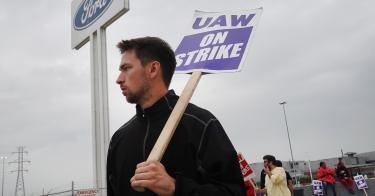The big economic news at the end of last week was the start of a strike by the United Auto Workers (UAW) union against all three major U.S. automakers. This is the first strike against President Biden’s green agenda, pitting two parts of the traditional Democratic coalition against each other—the environmentalists against the blue-collar workers, or simply the greens against the blues. At stake is the financial power of the UAW and the future of the Democratic Party as a representative of blue-collar workers.
The greens and the blues have generally come together to elect a series of Democratic presidents. Yes, there was a split over the Keystone XL pipeline, which the blues wanted for the jobs and the greens rejected because of the heavy crude that would be coming in from Canada. No matter that President Biden then begged the Venezuelans to sell America a similar heavy crude, this time coming to U.S. refineries by tanker rather than pipeline. This time, however, the green agenda is driving the UAW to strike, because banning the internal-combustion engine is equivalent to banning auto jobs.
The UAW is singing the blues because of the greens. UAW president Shawn Fain has refused to endorse President Biden for another term because of the president’s insistence on following California’s lead and ending sales of new internal-combustion-engine vehicles by 2035. The blue-collar workers want their jobs, but the greens care more about trees.
It doesn’t help that inflation is up for the second month in a row, and American Airlines, the West Coast dockworkers, and UPS have all gained pay raises of 30 percent to 40 percent over the next four years.
>>> How UAW’s Unrealistic Contract Demands Would Backfire on Union
The UAW is demanding a 35 percent hike in pay and benefits over four years, moderating its initial request for a 45 percent hike. The union is asking for automatic cost-of-living adjustments just as in the 1970s and a four-day rather than a five-day work week. The inflationary 1970s are calling President Biden, and they want their benefits back—with a post-pandemic four-day twist.
Ford Motor Company president Bob Farley estimates that the industry will need 40 percent fewer workers to produce EVs rather than gas-powered cars and light trucks. That’s 200,000 fewer jobs in 2030 and 400,000 fewer jobs in the long run.
Dwindling jobs lead to dwindling income. Many of the new jobs in EVs and batteries with Inflation Reduction Act funding are being created in right-to-work states, where wages are lower and workers do not have to join a union as a condition of employment.
Other jobs are being created in China, which has a lock on a substantial share of minerals required for EV batteries such as lithium, graphite, and cobalt. Mindful of the world’s concerns about China’s dominance in this area, Beijing is setting up factories in Indonesia to take advantage of minerals there, and the Chinese-built high-speed rail across the country from Jakarta to Bandung opened this month.
>>> Here’s a Principled Way for Workers “To Make Their Own Choices”
This is why switching to EVs is not only a major threat to the UAW, and its ability to negotiate higher wages for auto workers, but a mortal danger to the paycheck for Shawn Fain, as well as to the finances and political clout of the union.
Fain was elected UAW president in March 2023. Financial-disclosure forms with his salary are not currently available, but the UAW’s former president, Ray Curry, was paid $273,000 in 2021, according to UnionFacts.com, a nonprofit which compiles data from required Labor Department disclosure forms.
On the 2021 UAW financial-disclosure form, Shawn Fain was listed as an administrative assistant, with total compensation of $156,000 annually. That’s more than three times what the Bureau of Labor Statistics lists as an average salary for administrative assistants: $45,000. The UAW has $1.2 billion in assets and 372,000 members, according to UnionFacts.com. The UAW Political Action Committee has donated $50 million to Democrats and $2 million to Republicans.
And that’s the rub—despite the spending, the blue UAW can’t protect its members against the green government that it elected. Electrification is leading not only to shrinking worker incomes but to a fundamental fracturing of the Democratic Party coalition. That might be the most damaging part of the UAW strike.
This piece originally appeared in the National Review


